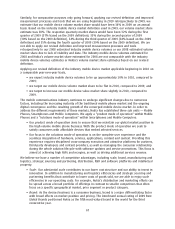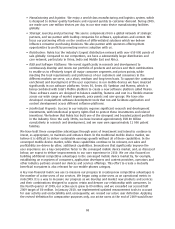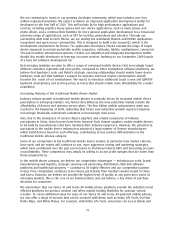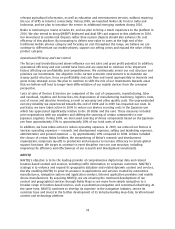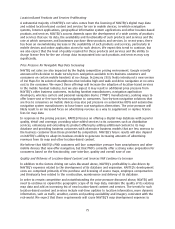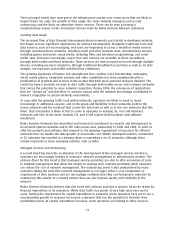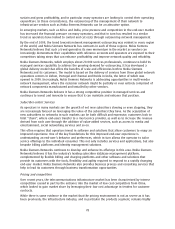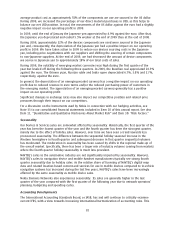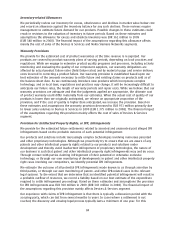Nokia 2009 Annual Report Download - page 78
Download and view the complete annual report
Please find page 78 of the 2009 Nokia annual report below. You can navigate through the pages in the report by either clicking on the pages listed below, or by using the keyword search tool below to find specific information within the annual report.continue to grow, despite a number of productivity initiatives underway to improve the efficiency of
our database collection processing and delivery.
Global Economic Conditions impacting NAVTEQ
Sales of our map database on mobile devices including PNDs and handsets grew in 2009 despite
unfavorable conditions in the consumer electronics industry primarily as a result of rapid deployment
of navigation by handset providers globally and by wireless carriers in the US. We expect to see
growth in navigation on mobile devices in 2010 while we believe that the global economic
environment is only gradually strengthening. With this rapid growth and continued uncertainty in the
automotive sector, we expect the percentage of NAVTEQ net sales derived from invehicle navigation
to decline in 2010 compared with 2009 and the percentage derived from mobile devices to increase
compared to 2009.
Nokia Siemens Networks
Nokia Siemens Networks provides mobile and fixed network solutions and related services to
operators and service providers. The principal source of Nokia Siemens Networks net sales are the
sale of telecommunications infrastructure hardware components throughout the network from the
access element, core networks and transport; the software and solutions that configure and manage
those networks, the voice and data traffic that flows through the networks as well as the information
operators use to build, manage and enhance the services they offer to endusers; and the provision of
network services, including the building of networks, maintenance and care services and, increasingly,
network management for operators.
Nokia Siemens Networks’ mission is to help customers build more valuable customer relationships.
The company endeavors to do this by improving efficiency in their key operational areas, in the
network and services provided to endusers. Nokia Siemens Networks also seeks to enhance the
communications experience the operators offer to their customers with their networks and their
services. Nokia Siemens Networks’ products, solutions and services are designed to enable efficient
lowcost connectivity, customer and content aware service delivery, flexible service creation and
management and customer and service specific communications experience.
Nokia Siemens Networks’ net sales depend on various developments in the mobile and fixed
infrastructure market, such as network operator investments, the pricing environment and product
mix. In developed markets, operator investments are primarily driven by capacity and coverage
upgrades, which, in turn, are driven by greater usage of the networks both for voice calls and,
increasingly, for data usage. Those operators are increasingly targeting investments in technology and
services that allow better management of users on their network, and also allow them to tap the
value of the large amounts of subscriber data under their control. Also, in developed markets, the
investments of network operators are driven by the evolution of network technologies and an
increasing need for efficiency. In emerging markets, the principal factors influencing operator
investments are growing customer demand for telecommunications services resulting from subscriber
growth. In many emerging markets, this continues to drive growth in network coverage both from
existing network providers and new entrants to markets.
Over recent years, the infrastructure industry has entered a more mature phase characterized by the
completion of the greenfield rollouts of mobile and fixed networks infrastructure across many
markets, although this is further advanced in developed markets. Despite this, there is still a
significant market for traditional network infrastructure products to meet coverage and capacity
requirements, even as older technologies such as 2G are supplanted by 3G and LTE. As growth in
traditional network products sales slows, there is an emphasis on the provision of network upgrades,
often through software, as well as applications, such as billing, charging and subscriber management,
and services, particularly the outsourcing of noncore activities to companies that provide extensive
telecommunications expertise and strong managed service offerings.
76



